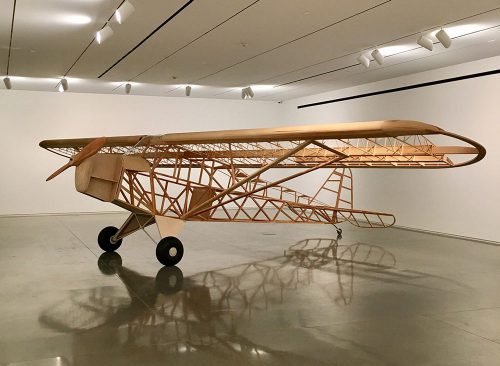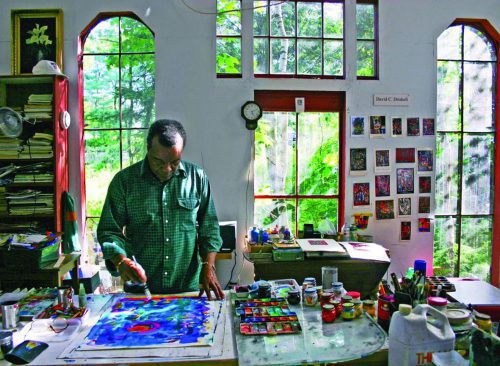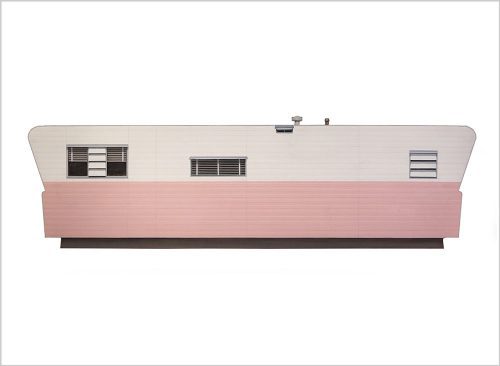
Piper Cub
Who can do anything better than this propeller? Can you? —Marcel Duchamp, speaking to Constantin Brancusi in front of an airplane, 1914
The most noticeable thing about artist Mark Wethli’s Piper Cub is that it’s incomplete; the abstract framework of an airplane rather than one that’s ready to fly. Piper Cub’s identity is further complicated, like Magritte’s famous pipe, by its uncertainty. Is it an actual plane, a sculpture of a plane, a full-scale model of a plane or in some sense (in its idealized, Platonic forms) the prototype of a plane? Although it’s not an actual aircraft (one that can be flown) it’s built from the original plans, identical to a real Piper Cub in every detail and dimension including the use of actual Piper Cub parts for the windshield, landing gear, and tires.
Significantly, Wethli has done nothing to artistically modify or interpret the plane, other than painstakingly recreating and presenting it (or, one might say, re-presenting it), suggesting that the “art” of the piece resides in its conceptual nature (posing questions such as the ones above) rather than its formal one.
At the same time, by presenting Piper Cub in a gallery setting, Wethli seems to beg the question of the aesthetic nature of mechanical objects and our categorical approach to beauty. By handcrafting the plane (with help from a team of friends and fellow artists in the final stages), Wethli seems to be encouraging us to look for beauty in unexpected places, not least of all in the contemplation of uncertainty, the joys of memory, and the beauty of sheer abstract form.
Mark Wethli (b. 1949) is a painter and public artist who lives and works in Brunswick, Maine, where he is also the A. LeRoy Greason Professor of Art at Bowdoin College. Continually asking the viewer to contemplate their own awareness of knowing and seeing, Wethli has explored many forms in his artwork including painting, sculpture and installation, both representational and abstract.
Piper Cub, 2007, pine, birch plywood and aircraft parts, 35 x 22 x 7 ft., private collection

David Driskell, Renewal and Form
“Religion and ritual and the mythic are concerns I have always nurtured in my art.” – David Driskell
Boldly drawn and richly patterned, David Driskell’s imagery in his prints, as in his collages and mixed media work, derives from his childhood experiences growing up in the rural South, his deep love for the Maine landscape, and his in-depth knowledge of and appreciation for African art and textiles. Presented in this exhibition are selected examples of the artist’s recent woodcuts, serigraphs, linocuts, and monoprints.
Widely respected as an artist, curator, educator, and scholar of African-American art, David Driskell (b. 1931, Eatonton, Georgia) has been a summer resident of Falmouth, Maine, since 1961. He was first introduced to the state while attending the Skowhegan School of Painting and Sculpture in 1953. When not in Maine, Driskell lives in Hyattsville, Maryland, where he is Professor Emeritus of Art at the University of Maryland, College Park, and where the David C. Driskell Center for the Study of the Visual Arts and Culture of African Americans and the African Diaspora honors his contributions to the field.
David Driskell began making prints in 1952 while attending Howard University in Washington, D.C. Professor James L. Wells, considered the dean of African-American printmakers at the time, introduced him to lithography and woodcuts. Woodcuts have remained a favorite medium throughout Driskell’s career. As he often did not have access to a printing press, he came to rely on the traditional manual method of producing relief prints: rubbing the back of the paper with a wooden spoon. Like the painter’s brush, a simple tool such as the spoon links the artist’s mind, eye, and hand directly to the work.
Exhibition Sponsor | Greenhut Galleries, Portland, Maine

Sam Cady, Parts of the Whole
“The world is emblematic. Parts of speech are metaphors, because the whole of nature is a metaphor of the human mind.” —Ralph Waldo Emerson
The first full-scale retrospective of the work of artist Sam Cady, this exhibition presents a broad selection of the artist’s emblematic shaped and rectangular paintings created over four decades, as well as a sampling of drawings, studies, and recent “fragments,” painted abstractions culled from the remainders of the shaped canvases. Ever tuned to seeing aesthetic possibility in the most mundane of objects, Cady turns these discards into explorations of pure color, form, and edge, adding another “part” to the whole.
Born in 1943 in Boothbay Harbor, Maine, Sam Cady has been sailing and exploring the coast of Maine his entire life and the imprint of the state’s rugged topography, numerous offshore islands, and waterfront industries is threaded through his art. After receiving a BA from the University of New Hampshire and an MFA from Indiana University, he taught in the graduate program at the School of Visual Arts, NYC, from 1984 to 2007. Throughout this period, he split his time between New York and his home and studio in Friendship, Maine, where he lives today. The urban/rural divide that defined his life for so many years is evident in the range of his subjects from highway overpasses to boats on jack stands.
Foe more information, visit http://cmcanow.org/
Categories: exhibitions, gallery, Rockland, Rockland, shows
Tags:

